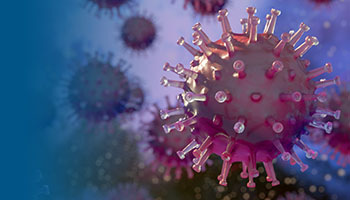HOW CAN WE HELP YOU? Call 1-800-TRY-CHOP
In This Section
From Mutations to Mask Mandates, New Insights Into SARS COV-2 Diversity

New findings from our researchers shed light on the importance of mask mandate policies and the impact of human immunity on SARS COV-2’s viral diversity.
limjr [at] chop.edu (By Jillian Rose Lim)
As variants of SARS COV-2, the virus that causes COVID-19, emerge around the world, Children’s Hospital of Philadelphia researchers are tracking how the multiple mutations arise and affect our communities in real time.
Last fall, we sat down with Paul Planet, MD, PhD, and Ahmed Moustafa, PhD, creators of a novel technology that traces the evolution of SARS COV-2. Now, through use of that tool, GNU-based Virus Identification (GNUVID), Drs. Planet and Moustafa have gathered new findings that shed light on the importance of mask mandate policies and the impact of human immunity on viral diversity. By better understanding viral diversity, scientists are better positioned to detect concerning mutations and develop effective approaches to treatment and prevention.
“Studying viral diversity is important because there’s always the prospect that variants become biologically different and have less similarity with vaccines being administered,” said Dr. Planet, an attending physician in the Division of Infectious Diseases. “The way that you get diversity down is to keep it from spreading and thus reduce the overall population size of the virus. In my lab, I wanted to know whether we could tie the diversity of the SARS COV-2 virus in a population to something that occurred in real life.”
To do this, Dr. Moustafa, a previous postdoctoral fellow in the Division of Infectious Diseases and currently lead scientist in the Microbial Archive and Cryo-collection (MARC) unit under the PennCHOP Microbiome Program, identified the dates in which mask mandates were put into place for 16 states in the U.S. and set out to learn about the circulating diversity in those states over the period of the pandemic. Using GNUVID, Drs. Planet and Moustafa can categorize and follow new mutants as they arise, and then track those pathogens back to their closest relatives and to others circulating around the world. With even more data added to the GISAID database since the team began their research — a total of about 170,000 global genomes and about 26,000 genomes from the U.S. — the scientists came up with a handful of key insights.
First, data showed states that instituted mandates for mask-wearing appeared to have very low viral diversity, whereas states that were either late adopters of mandated mask-wearing, or that never instituted one at all (like Florida), seemed to have much higher viral diversity.
“There appears to be a linear correlation between when you put your mask mandate into effect and what your viral diversity looks like,” Dr. Planet said. “There are a couple of outliers — for some reason, Texas and California had middle-of-the-road mask mandates, and they both have very high circulating diversity. In general, however, it sort of follows a linear correlation. And what that means is that in order to keep variants from arising, you need to develop measures to stop the spread of the virus earlier.”
Drs. Planet and Moustafa then looked at whether some of the variants might be associated with severity of illness. “We weren’t able to correlate any of the variants with severity of illness,” said Dr. Planet. “Those variants that were sort of newer — associated with the second entrance of SARS COV-2 into the U.S. — seemed to cause just as severe, or not as severe, disease as the early variants that were identical to the ones that came out of Wuhan.”
Finally, the team compared viral diversity in a Philadelphia population of adults versus pediatric patients over time. Though at first children appeared to have a greater number of variants than adults, more recent findings showed children had same number of variants as adults.
“This is encouraging because if viral diversity is happening at approximately the same frequency, perhaps kids are not the big ‘vessels’ of SARS COV-2 we thought them to be,” Dr. Planet said.
Variants, Selective Pressure, and Immunity
In a more recent study, Drs. Planet and Moustafa honed in on a particular set of isolates, belonging to the B.1.1.7 lineage that also harbors the E484K mutation — a mutation that has been shown to promote escape from neutralizing antibodies, or immunity, in vitro.
A number of the B.1.1.7 isolates with this mutation have been reported in the U.S. this year, and a larger number have been reported globally. Interestingly, the team’s analysis using GNUVID showed seven distinct clonal groups that bear the E484K mutation, suggesting each group may have developed the mutation independently. Furthermore, Drs. Planet and Moustafa reported identification of one of the first B.1.1.7 isolates with the E484K mutation in Pennsylvania.
“When we look at all the B.1.1.7 isolates with all the mutations available in the global database, there seemed to be seven different lineages that had all acquired the same mutation,” Dr. Planet said. “That suggests there’s a strong selective pressure for gaining this mutation in different viruses.”
Dr. Planet said the virus may be seeing this selective pressure for this mutation because of rising vaccines or human immunity from having previously had COVID-19. The findings highlight the need for increased genomic surveillance to detect emerging variants that may be less susceptible to either natural or vaccine-induced immunity.
“One way to look at this research is that it highlights the need to go get your vaccine as soon as possible, because that’s what’s going to protect you best,” Dr. Planet said. “Variants arise because you have a huge population size, so if you can push down the number of viruses, that will have a huge impact on the number of mutations that can arise. The fewer hosts, the fewer chances it has to mutate.”
Learn more about GNUVID in our Q&A with Drs. Planet and Moustafa.